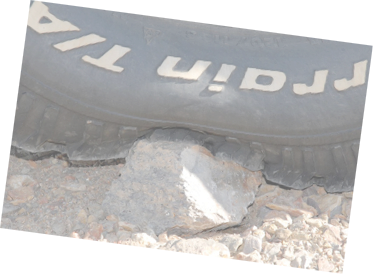techniques


Lowering your tyre pressures
Some tyres have softer sidewalls and “BAG” easy, others need to have less pressure to get them to “BAG”. How much air you let out of your tyres is up to you. It depends on the type of tyre, the load being carried and the sort of terrain you are driving on. It allows the tread to "mould" itself over rocks and obstacles, thus providing better traction.
In sandy or muddy conditions it will widen the contact area of the tyre and provide better "float". Lower pressures make the tyres softer, which provides an extra dimension of subtlety to the suspension. This reduces the tendency of the front wheels to bounce on small ledges and rocks.
Never drive too fast on very low tyre pressures. This can cause them to separate from the rim, instant flat, and possible loss of control.
Be careful with very low pressures on chrome or Alloy rims, as these are sometimes so slippery that the tyres have been known to de-seat their beads.
Always use valve caps, preferably the metal ones as they have a sealing “O’ ring this prevents dirt from getting into the valve, causing it to stick open.

Your vehicle manual will have the recommended pressures for on-road. When you go off road, it is necessary to lower those pressures to suit the terrain and type of tyre you have.
Re-inflate to normal pressures as soon as you don’t need to have them deflated. Most club members invest in a compressor. A quality one starts at about $200 + and should serve you well for years.






SRODRV001B/01 IDENTIFY 4WD SPECIFIC TERMS, TERMINOLOGY AND TECHNIQUES
PERFORMANCE CRITERIA 01c


